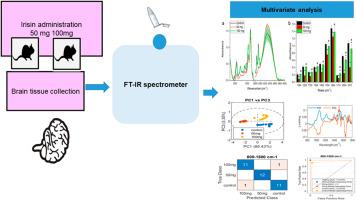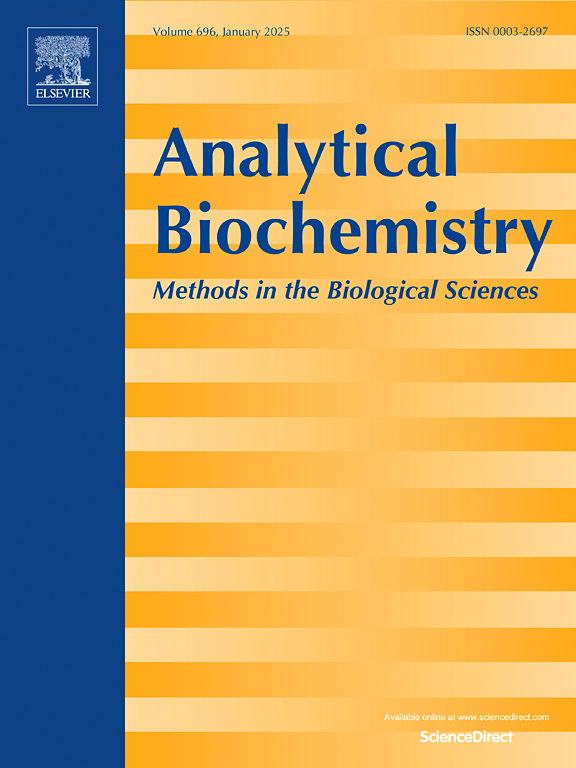利用光谱学和机器学习技术研究施用鸢尾素诱导的大鼠大脑下丘脑化学成分变化
IF 2.6
4区 生物学
Q2 BIOCHEMICAL RESEARCH METHODS
引用次数: 0
摘要
本研究采用傅立叶变换红外光谱(FTIR)测定脑组织的化学成分以及鸢尾素在 50 毫克和 100 毫克剂量下引起的变化。采集了对照组大鼠和服用鸢尾素组大鼠的脑组织,并对关键振动峰进行了分析。与对照组相比,50 毫克鸢尾素组的所有描述振动都有所下降,而 100 毫克组只显示脂质振动有所下降。与 100 毫克组相比,50 毫克组的磷脂、酰胺和脂质官能团的吸光度较低。与对照组相比,处理组组织中这些化合物的含量较低,而 100 毫克组的含量较高。酰胺峰之间的比率显示组间存在显著差异。主成分分析(PCA)主要利用 PC1 和 PC3 对对照组和鸢尾素处理组的组织进行区分。决策树模型显示出较高的分类准确性,尤其是在 800-1800 cm-1 范围内,具有较高的灵敏度和特异性。傅立叶变换红外光谱有效地突出了鸢尾素引起的脑组织化学变化,并显示出剂量依赖性变化。PCA、ROC分析和决策树模型的结合强调了傅立叶红外光谱在研究鸢尾素等化合物的生化效应方面的潜力。本文章由计算机程序翻译,如有差异,请以英文原文为准。

Chemical composition alterations in rat brain hypothalamus induced by irisin administration using spectroscopic and machine learning techniques
This study employed Fourier transform infrared (FTIR) spectroscopy to determine the chemical composition of brain tissues and the changes induced by irisin at doses of 50 mg and 100 mg. Brain tissues were collected from control rats and those administered with irisin, and key vibrational peaks were analyzed. In the 50 mg irisin group, all described vibrations decreased compared to control tissues, while the 100 mg group showed a decrease only in lipid vibrations. Comparatively, the 50 mg group had lower absorbance of phospholipids, amides, and lipid functional groups than the 100 mg group. Lower amounts of these compounds were found in treated tissues compared to controls, with higher levels in the 100 mg group. Ratios between amide peaks revealed significant differences between groups. Principal component analysis (PCA) differentiated control and irisin-treated tissues, primarily using PC1 and PC3. The decision tree model exhibited high classification accuracy, especially in the 800–1800 cm⁻1 range, with high sensitivity and specificity. FTIR spectroscopy effectively highlighted chemical changes in brain tissues due to irisin, demonstrating dose-dependent variations. The combination of PCA, ROC analysis, and decision tree modeling underscored the potential of FTIR spectroscopy for studying the biochemical effects of compounds like irisin.
求助全文
通过发布文献求助,成功后即可免费获取论文全文。
去求助
来源期刊

Analytical biochemistry
生物-分析化学
CiteScore
5.70
自引率
0.00%
发文量
283
审稿时长
44 days
期刊介绍:
The journal''s title Analytical Biochemistry: Methods in the Biological Sciences declares its broad scope: methods for the basic biological sciences that include biochemistry, molecular genetics, cell biology, proteomics, immunology, bioinformatics and wherever the frontiers of research take the field.
The emphasis is on methods from the strictly analytical to the more preparative that would include novel approaches to protein purification as well as improvements in cell and organ culture. The actual techniques are equally inclusive ranging from aptamers to zymology.
The journal has been particularly active in:
-Analytical techniques for biological molecules-
Aptamer selection and utilization-
Biosensors-
Chromatography-
Cloning, sequencing and mutagenesis-
Electrochemical methods-
Electrophoresis-
Enzyme characterization methods-
Immunological approaches-
Mass spectrometry of proteins and nucleic acids-
Metabolomics-
Nano level techniques-
Optical spectroscopy in all its forms.
The journal is reluctant to include most drug and strictly clinical studies as there are more suitable publication platforms for these types of papers.
 求助内容:
求助内容: 应助结果提醒方式:
应助结果提醒方式:


